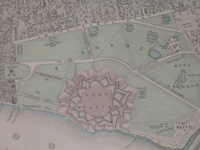Difference between revisions of "Chapter 57: 562-569"
Greenlantern (Talk | contribs) (→Page 563) |
Greenlantern (Talk | contribs) (→Page 564) |
||
| Line 21: | Line 21: | ||
'''Sacques'''<br> | '''Sacques'''<br> | ||
The robe à la française or sack-back gown with flowing pleats from the shoulders was originally an undress fashion. At its most informal, this gown was unfitted both front and back and called a sacque. Later, for formal wear, the front was fitted to the body by means of a tightly-laced underbodice, while the back fell in loose box pleats called "Watteau pleats" from their appearance in the paintings of Antoine Watteau. From [http://en.wikipedia.org/wiki/1700-1750_in_fashion WIKI] | The robe à la française or sack-back gown with flowing pleats from the shoulders was originally an undress fashion. At its most informal, this gown was unfitted both front and back and called a sacque. Later, for formal wear, the front was fitted to the body by means of a tightly-laced underbodice, while the back fell in loose box pleats called "Watteau pleats" from their appearance in the paintings of Antoine Watteau. From [http://en.wikipedia.org/wiki/1700-1750_in_fashion WIKI] | ||
| + | |||
| + | '''Eyre Coote'''<br> | ||
| + | See page [http://masondixon.pynchonwiki.com/wiki/index.php?title=Chapter_49:_476-483#Page_478 478]. | ||
==Page 566== | ==Page 566== | ||
Revision as of 16:06, 21 October 2009
Page 562
Chester TownChester is a town in Orange County, New York, United States... The town is named after another city in Great Britain. Chester contains a village, also called Chester. The town was first settled around 1721. The economy of the early town was based on dairy products. From WIKI
The Black Hole of Calcutta
See page 483.
Fort William
Fort William is a fort built in Calcutta on the Eastern banks of the River Hooghly, the major distributary of the River Ganges, during the early years of the Bengal Presidency of British India. It was named after King William III of England. In front of the Fort is the Maidan, which used to be a part of the Fort and is the largest urban park in Calcutta. From WIKI
Page 563
Bengal
See page 404.
Howdah
A howdah, or houdah, is a carriage which is positioned on the back of an elephant, or occasionally some other animal, used most often in the past to carry wealthy people or for use in hunting or warfare. It was also a symbol of wealth for the owner, and as a result were decorated with expensive gems. From WIKI
Page 564
Polonaises
A polonaise (originally robe à la Polonaise) is a woman's garment of the later 1770s and 1780s or a similar revival style of the 1880s inspired by Polish national costume, consisting of a gown with a fitted bodice and cutaway, draped and poufed overskirt, worn over an underskirt or petticoat. The eighteenth century polonaise (also referred to as a milkmaid dress) was a conscious imitation of rustic country women's habit of tucking their outer gowns up to keep them out of the muck. From WIKI
Sacques
The robe à la française or sack-back gown with flowing pleats from the shoulders was originally an undress fashion. At its most informal, this gown was unfitted both front and back and called a sacque. Later, for formal wear, the front was fitted to the body by means of a tightly-laced underbodice, while the back fell in loose box pleats called "Watteau pleats" from their appearance in the paintings of Antoine Watteau. From WIKI
Eyre Coote
See page 478.
Page 566
Info on Sons of Liberty Activities in New-York.
here and here.
